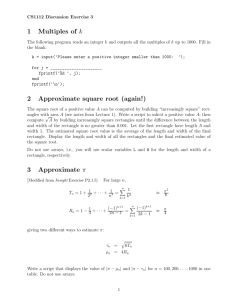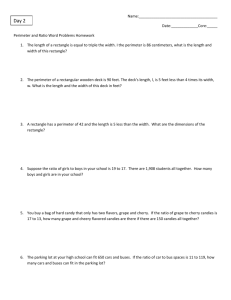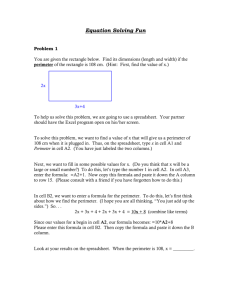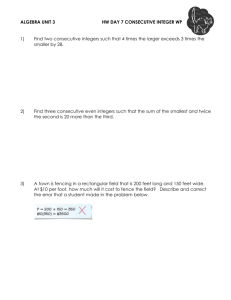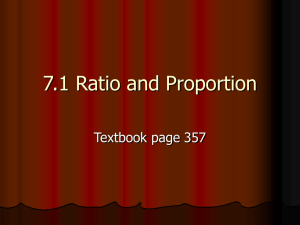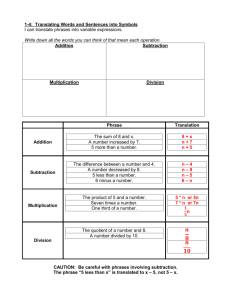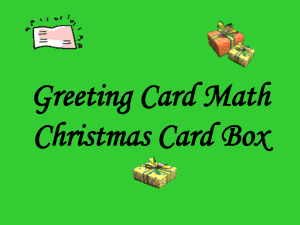Lesson 4: Exponents and Volume
advertisement
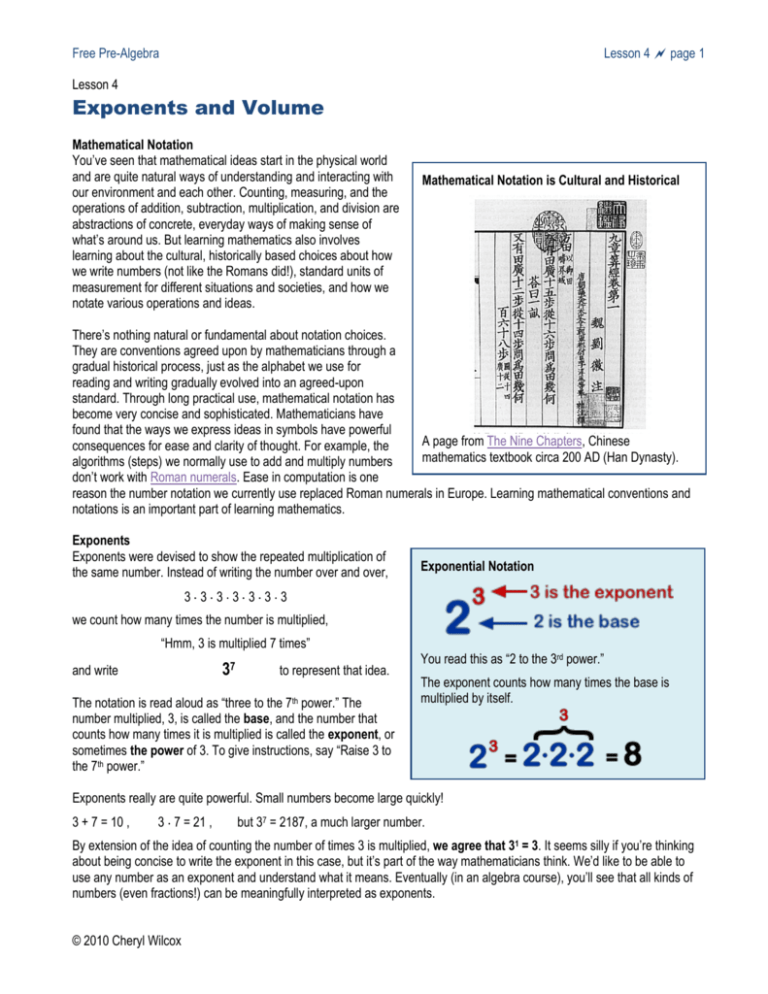
Free Pre-Algebra Lesson 4 page 1 Lesson 4 Exponents and Volume Mathematical Notation You’ve seen that mathematical ideas start in the physical world and are quite natural ways of understanding and interacting with our environment and each other. Counting, measuring, and the operations of addition, subtraction, multiplication, and division are abstractions of concrete, everyday ways of making sense of what’s around us. But learning mathematics also involves learning about the cultural, historically based choices about how we write numbers (not like the Romans did!), standard units of measurement for different situations and societies, and how we notate various operations and ideas. Mathematical Notation is Cultural and Historical There’s nothing natural or fundamental about notation choices. They are conventions agreed upon by mathematicians through a gradual historical process, just as the alphabet we use for reading and writing gradually evolved into an agreed-upon standard. Through long practical use, mathematical notation has become very concise and sophisticated. Mathematicians have found that the ways we express ideas in symbols have powerful A page from The Nine Chapters, Chinese consequences for ease and clarity of thought. For example, the mathematics textbook circa 200 AD (Han Dynasty). algorithms (steps) we normally use to add and multiply numbers don’t work with Roman numerals. Ease in computation is one reason the number notation we currently use replaced Roman numerals in Europe. Learning mathematical conventions and notations is an important part of learning mathematics. Exponents Exponents were devised to show the repeated multiplication of the same number. Instead of writing the number over and over, Exponential Notation 3 3 3 3 3 3 3 we count how many times the number is multiplied, “Hmm, 3 is multiplied 7 times” 37 and write to represent that idea. 7th The notation is read aloud as “three to the power.” The number multiplied, 3, is called the base, and the number that counts how many times it is multiplied is called the exponent, or sometimes the power of 3. To give instructions, say “Raise 3 to the 7th power.” You read this as “2 to the 3rd power.” The exponent counts how many times the base is multiplied by itself. Exponents really are quite powerful. Small numbers become large quickly! 3 + 7 = 10 , 3 7 = 21 , but 37 = 2187, a much larger number. By extension of the idea of counting the number of times 3 is multiplied, we agree that 31 = 3. It seems silly if you’re thinking about being concise to write the exponent in this case, but it’s part of the way mathematicians think. We’d like to be able to use any number as an exponent and understand what it means. Eventually (in an algebra course), you’ll see that all kinds of numbers (even fractions!) can be meaningfully interpreted as exponents. © 2010 Cheryl Wilcox Free Pre-Algebra Lesson 4 page 2 Evaluating Exponential Expressions A number with an exponent is called “an exponential expression.” “Evaluate” in mathematics means “find the value of,” i.e., find what number this is equal to. So “evaluate the exponential expression” just means “See this number with an exponent? Find what number it’s equal to, when it’s multiplied out.” With Pencil and Paper Write out the expression as a multiplication, then multiply to find the answer. Example: Evaluate the exponential expression 43. 43 = 4 4 4 = 16 4 = 64 With a Scientific Calculator Find the exponent key on your calculator. The key usually looks like this: (called a caret) or this: often used to indicate an exponent when typing something where it’s hard to raise a number above the line. . A caret is To calculate, enter the base number, press the exponent key, then enter the exponent number. Press the equals key and read off the answer. Example: Evaluate the exponential expression 43. Enter 4 ^ 3 = Your calculator should display 64 as the answer. Exponent Keys on Two Popular Scientific Calculators Powers of Ten Tens are easy to multipy, because our number system is based on 10s. So 102 = (10 )(10 )= 100, 103 = (10 )(10 )(10 ) = 1000, 104 = 10,000 and so forth. You can notice quickly that the exponent tells you how many zeros to write after the 1. (This trick doesn’t work for other numbers! 73 is NOT 7000!) In fact, the powers of 10 are just the place value groups: 103 is one thousand, 104 is ten thousand, 106 is one million, etc. © 2010 Cheryl Wilcox Free Pre-Algebra Lesson 4 page 3 The 2nd Power is a Square A square is a rectangle with all four sides equal. To find the area of a square, we multiply length times width, like any other rectangle. But since the length and width are the same, we are doing a repeated multiplication. Length 2 cm, Width 2 cm Length 3 cm, Width 3 cm Length 4 cm, Width 4 cm Area = 2 2 square cm 4 square cm. Area = 3 3 square cm 9 square cm. Area = 4 4 square cm 16 square cm. Because of this, the 2nd power is often called “the square.”. The notation 52 is often read “5 squared” because the area of a square with side 5 units is 52 = 25 square units. The numbers that are the result of squaring are called square numbers. Square Numbers 12 22 32 42 1 16 25 36 49 64 81 100 121 144 … 4 9 52 62 72 82 92 102 112 122 … Square units are often abbreviated with an exponent: square cm becomes cm2 square inches becomes in2 square meters becomes m2 Notice that we write the exponent AFTER the unit, not before. Even though we say “square feet” we write “ft2.” The exponent always applies to whatever it follows. If you write 42cm, that means 16 cm, (because the 2 applies to the 4 it follows). 42cm (or even 4 2cm) does NOT mean 4 square cm. To abbreviate 4 square cm, write 4 cm2. This notation works very well with the area formula. Example: Find the area of a rectangle with length 5 feet and width 7 feet. Area = Length x Width = (5 feet) (7 feet) = (5 7) (feet feet) = 35 ft2 It seems strange to multiply units of length, (they aren’t numbers!), but you’ll see that multiplying and dividing units is useful in many situations. (which means 35 square feet) The 3rd Power is a Cube If you’re packing this box, knowing the area it occupies on the floor is not enough. The depth of the box is also important. The measure of the space inside the box is called its volume. Area is measured with flat squares. Volume is measured with cubes. A square centimeter measuring area has length 1 cm and width 1 cm. A cubic centimeter, measuring volume, has length 1 cm, width 1 cm, and depth (or height) 1 cm. © 2010 Cheryl Wilcox Free Pre-Algebra Lesson 4 page 4 In the same way we calculate the area of a rectangle using length and width, we can calculate the volume of a box using the length, width, and depth (same as height). These are called the dimensions of the box. Make Your Own Cubic Inch Block Fold the box to make a block that measures 1 cubic inch. Note that printers and copy machines may change the size slightly. Below see a box, measured in cubic centimeters. The bottom of the box has length 5 cm and width 3 cm. That means that each layer of the box has 15 blocks. Since the height of the box is 4 cm, there are 4 layers. The total number of blocks is 4 layers of 15 blocks each, or 60 blocks. So the volume is 60 cubic centimeters. We can codify this process for any box: The volume is the height (number of layers) multiplied by the area of the bottom (number of blocks in each layer. Volume of Box = Height x (Area of Bottom) or Volume of Box = Height x Length x Width This is usually rearranged: Volume = Length x Width x Height and abbreviated in algebraic notation V = LWH The orientation of the rectangle didn’t affect the perimeter and area, and the box, too, can be turned any which way and the volume remains the same. So it doesn’t really matter which dimension is called the length or width or height. Example: Find the volume of a box with length 7 cm, width 8 cm, and height 3 cm. Substitute the numbers into the formula: Volume = Length x Width x Height = (7 cm) (8 cm) (3 cm) = (7 8 3) (cm cm cm) = 168 cm3 Here’s that trick again with the units. Since cm is “multiplied” three times, the result is cm3, which we interpret as cubic centimeters. (which means 168 cubic centimeters) This is why the third power is also called “cubed.” 23 can be read as “two to the 3rd power” OR as “two cubed.” © 2010 Cheryl Wilcox Free Pre-Algebra Lesson 4 page 5 If the length, width, and height of a box are all equal, the box is a cube. The volume will be the third power of the side. If the side is … 1 2 3 4 5 6 7 8 9 10 The volume is … 13 23 33 43 53 63 73 83 93 103 Cubic Numbers 27 64 125 216 343 512 729 1000 … 1 8 … Example: Find the volume of a cube with side 10 cm. Substitute the numbers into the formula: Volume = = Length x Width x Height (10 cm) (10 cm) (10 cm) = (10 10 10) (cm cm cm) = = 103 cm3 1000 cm3 or 1000 cubic cm Three Dimensions You may have watched a movie in 3-D. The D stands for dimensions, and 3-D is an abbreviation of 3-dimensional. This means the film, although projected on a flat screen, gives the illusion of depth to the flat objects (when viewed through the special glasses). Volume measures 3-dimensional space Measure length with a ruler. Area of rectangle = LW Volume of box = LWH A line is one-dimensional. Dimensions: Length only. Units: cm, inches, km, miles An area is two-dimensional. Dimensions: Length and Width. Units: cm2, in2, km2, mi2 A solid object is three-dimensional. Dimensions: Length, Width, Height Units: cm3, in2, km3, mi3 A driver on a highway navigates in one dimension. You can only go either forward or back. A boat navigates in two dimensions. You can travel on the surface of the water, but not above or below. A plane navigates in three dimensions. You can travel north, south, east, west, AND up and down. © 2010 Cheryl Wilcox Free Pre-Algebra Lesson 4 page 6 Lesson 4: Exponents and Volume Worksheet Name 1. Fill in the table with the powers of two. Exponent 1 2 3 2 ^ Exponent 21 22 23 Evaluate 2 2•2 = 4 The powers of 2 use 2 as the 4 5 6 , the square numbers use 2 as the exponent or base? Square Numbers 7 . exponent or base? 12 22 32 42 52 62 72 82 92 102 112 122 1 4 9 16 25 36 49 64 81 100 121 144 2. Fold a piece of paper in half once. It’s now two layers thick. If you fold it in half again, it’s four layers thick. You’ve doubled the number of layers. Don’t just imagine folding the paper. Actually do it. Then record the number of layers after each fold in the table below. Number of Folds 0 1 2 1 2 4 3 4 5 6 Paper looks like How many layers? 3. The table in the first problem relates to the table in the second problem. Fill in the blanks: Each time you fold the paper the number of layers is multiplied by If you use the number of folds as the How many layers of paper will there be after the 7th fold? , and . as the base, you can find the number of layers. Were you able to fold the paper seven times? Have you heard that it’s impossible to fold a piece of paper more than 7 or 8 times? Many people believed this had been proven, so Britney Gallivan’s high school math teacher thought it was pretty safe to offer extra credit for anyone who folded anything more than eight times. Britney, however, decided it could be done, and in January 2002 set a new world record by folding first gold foil and then toilet paper in half a whopping 12 times. Curious? How many layers will there be after the 12th fold? © 2010 Cheryl Wilcox Free Pre-Algebra Lesson 4 page 7 Pyramid scheme From Wikipedia, the free encyclopedia A pyramid scheme is a non-sustainable business model that involves the exchange of money primarily for enrolling other people into the scheme, without any product or service being delivered. Pyramid schemes are a form of fraud. In the pyramid shown The top person (originator) recruits 6 people (Level 1 Recruits), each of whom pay $1000 to join. Originator’s profit is $6000. Each of the 6 people in Level 1 recruit 6 more people. The new people (Level 2) pay $1000 to the person that recruited them. So far, each person in the first level of recruits has received $6000 from the Level 2 recruits, and has paid $1000 to the originator to join. Each Level 1 Recruit has a profit of $5000. Repeat, with each new person recruiting 6 more people. Each level has 6 times as many people as the previous level. 4. Use exponents to see where the numbers on the Wikipedia pyramid graphic come from: Exponent (Level in Scheme) 1 2 3 6 ^ Exponent 61 62 63 Evaluate the expression (Number of people per Level) 6 4 5 6 7 5. Why is the business model “non-sustainable”? 6. If the number of recruits at each level is changed to 8, how many people would be involved at the 4th level? Discuss: In the Pyramid Scheme, the number of people in Level 3 is found by evaluating 63. If you consider the originator to be Level 0, what do you think the expression 60 should be equal to? In the paper folding problem, you saw that a paper folded 3 times has 23 = 8 layers. If you consider the starting position to be the unfolded paper (with zero folds), the expression 20 should represent the number of layers. What number do you think 20 should be? What power of 10 should be written in the 1s place? © 2010 Cheryl Wilcox Free Pre-Algebra Lesson 4 page 8 Lesson 4: Exponents and Volume Homework 4A Name 1. Estimate the number of bananas in the photo. 2. Evaluate the power of 10, then write the number in words. a. 103 b. 106 c. 109 d. 1012 www.stevehopson.com 3. Round the number a. 678,901 to the nearest hundred thousand. 4. Measure the length and width of the rectangle in centimeters. Then use your measurements to find the area and perimeter of the rectangle. Include units with answers. b. 3,407 meters to 2 significant figures. c. Using your judgment: “Americans discard 2,074,543,519 pounds of used clothing and textiles into the landfills each year.” Perimeter _______ 5. Find the perimeter of the figure. 6. Find the perimeter and area of the figure. Units are cm and cm2. Perimeter ______ © 2010 Cheryl Wilcox Area ________ Area ______ Free Pre-Algebra 7. Write the formula for the perimeter of a rectangle in algebraic notation: Perimeter = 2(Length) + 2(Width) Write the alternate formula for the perimeter of a rectangle in algebraic notation: Perimeter = 2(Length + Width) 9. Write the formula for the area of a rectangle in words and in algebraic notation: Lesson 4 page 9 8. Find the perimeter of each rectangle: a. Length 46 m, Width 39 m. b. Length 129 feet, width 206 feet. c. Length 400 miles, Width 750 miles. 10. Find the area of each rectangle. a. Length 19 yards, Width 22 yards. b. Length 20 inches, Width 20 inches 11. Write the algebraic form. Volume of box = Length • Width • Height What would the units of volume be if a box had sides measured in inches? 12. Find the volume of each box. a. Length 22 inches, Width 18 inches, Height 4 inches b. Length 300 yards, Width 200 yards, Height 150 yards. Spelled out: Abbreviated: 13. Write out each exponential expression as a multiplication, and evaluate. a. 58 b. 85 c. Length 1 mile, Width 3 miles, Height 2 miles. 14. Use a scientific calculator to evaluate each expression. a. 29 b. 77 c. 176 Units! Don’t forget. Go back and check. © 2010 Cheryl Wilcox Free Pre-Algebra Lesson 4 page 9 Lesson 4: Exponents and Volume Homework 4A Answers 1. Estimate the number of bananas in the photo. 2. Evaluate the power of 10, then write the number in words. a. 103 1,000 one thousand b. 106 1,000,000 one million c. 109 1,000,000,000 one billion d. 1012 www.stevehopson.com 3. Round the number a. 678,901 to the nearest hundred thousand. 700,000 1,000,000,000,000 one trillion 4. Measure the length and width of the rectangle in centimeters. Then use your measurements to find the area and perimeter of the rectangle. Include units with answers. b. 3,407 meters to 2 significant figures. 3,400 meters c. Using your judgment: “Americans discard 2,074,543,519 pounds of used clothing and textiles into the landfills each year.” about 2 billion P = 2(6 cm + 4 cm) = 2(10 cm) = 20 cm A = (6 cm)(4 cm) = 24 cm2 Perimeter 20 cm 5. Find the perimeter of the figure. 10 ft + 20 ft + 10 ft + 7 ft + 5 ft + 8 ft + 5 ft + 5 ft = 70 ft © 2010 Cheryl Wilcox Area 24 cm2. 6. Find the perimeter and area of the figure. Units are cm and cm2. Perimeter 28 cm Area 13 cm2 . Free Pre-Algebra Lesson 4 page 10 7. Write the formula for the perimeter of a rectangle in algebraic notation: Perimeter = 2(Length) + 2(Width) P = 2L + 2W Write the alternate formula for the perimeter of a rectangle in algebraic notation: Perimeter = 2(Length + Width) P = 2(L + W) 8. Find the perimeter of each rectangle: a. Length 46 m, Width 39 m. P = 2(46 m + 39 m) = 2(85 m) = 170 m. b. Length 129 feet, width 206 feet. P = 2(129 ft + 206 ft) = 2(335 ft) = 670 feet c. Length 400 miles, Width 750 miles. P = 2(400 mi + 750 mi) = 2(1150 mi) = 2300 miles 9. Write the formula for the area of a rectangle in words and in algebraic notation: Area = Length x Width A = LW 10. Find the area of each rectangle. a. Length 19 yards, Width 22 yards. A = (19 yd)(22 yd) = 418 yd2 b. Length 20 inches, Width 20 inches A = (20 in)(20 in) = 400 in2 11. Write the algebraic form. 12. Find the volume of each box. Volume of box = Length • Width • Height V = LWH What would the units of volume be if a box had sides measured in inches? a. Length 22 inches, Width 18 inches, Height 4 inches V = (22 in)(18 in)(4 in) = 1584 in3 b. Length 300 yards, Width 200 yards, Height 150 yards. V = (300 yd)(200 yd)(150 yd) = 9,000,000 yd3 c. Length 1 mile, Width 3 miles, Height 2 miles. Spelled out: cubic inches V = (1 mi)(3 mi)(2 mi) = 6 mi3 Abbreviated: in3 13. Write out each exponential expression as a multiplication, and evaluate. a. 58 5 • 5 • 5 • 5 • 5 • 5 • 5 • 5 = 390,625 14. Use a scientific calculator to evaluate each expression. a. 29 = 512 b. 77 = 823,543 c. 176 = 24,137,569 b. 85 8 • 8 • 8 • 8 • 8 = 32,768 Units! Don’t forget. Go back and check. © 2010 Cheryl Wilcox Free Pre-Algebra Lesson 4 page 11 Lesson 4: Exponents and Volume Homework 4B 1. Estimate the number of tomatoes that can be seen in the photo. Name 2. Evaluate the power of 10, then write the number in words. a. 102 b. 104 c. 108 d. 1010 3. Round the number a. 92,831,300,871 to the nearest hundred million. 4. Measure the length and width of the rectangle in inches. Then use your measurements to find the area and perimeter of the rectangle. Include units with answers. b. 92,831,300,871 cm2 to 5 significant figures. c. Using your judgment: “Football (or soccer as it is known Canada, Samoa and the United States) is a popular sport that is enjoyed across many cultures and countries, with 243,761,953 registered players, and fans in the billions.” Perimeter 5. Find the perimeter of the figure. . 6. Find the perimeter and area of the figure. Units are cm and cm2. Perimeter © 2010 Cheryl Wilcox Area Area . Free Pre-Algebra Lesson 4 page 12 7. Write the formula for the perimeter of a rectangle in words: P = 2L + 2W 8. Find the perimeter of each rectangle: a. Length 75 m, Width 60 m. b. Length 145 feet, width 99 feet. Write the alternate formula for the perimeter of a rectangle in words: P = 2(L + W) 9. Write the formula for the area of a rectangle in words and in algebraic notation: c. Length 22 miles, Width 68 miles. 10. Find the area of each rectangle. a. Length 213 m, Width 212 m. b. Length 77 feet, Width 98 feet 11. Write the formula for the volume of a box in words. V = LWH What would the units of volume be if a box had sides measured in meters? 12. Find the volume of each box. a. Length 1 foot, Width 1 foot, Height 1 foot b. Length 12 inches, Width 12 inches, Height 12 inches. Spelled out: c. Length 15 miles, Width 12 miles, Height 10 miles. Abbreviated: 13. Write out each exponential expression as a multiplication, and evaluate. a. 74 b. 47 14. Use a scientific calculator to evaluate each expression. a. 210 b. 157 c. 203 Units! Don’t forget. Go back and check. © 2010 Cheryl Wilcox


